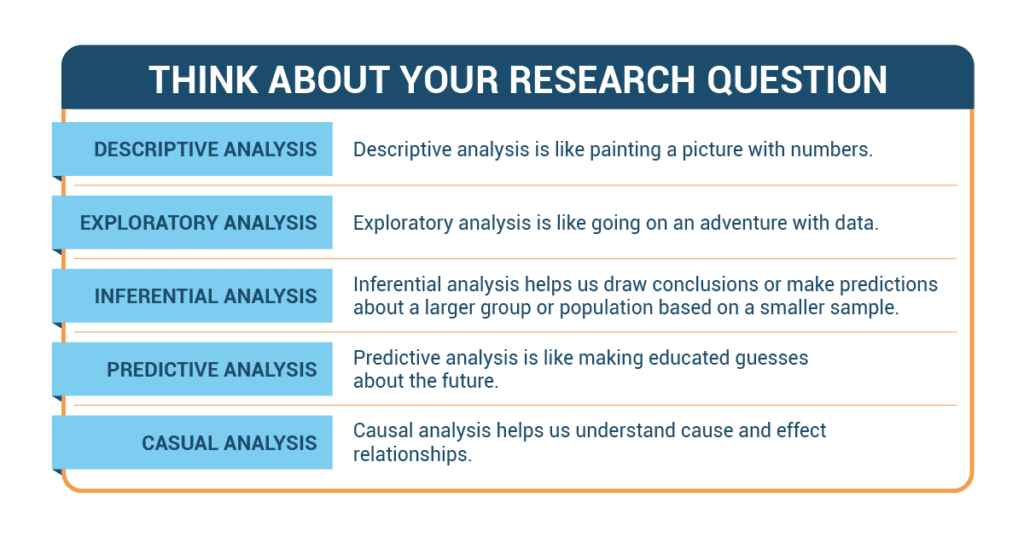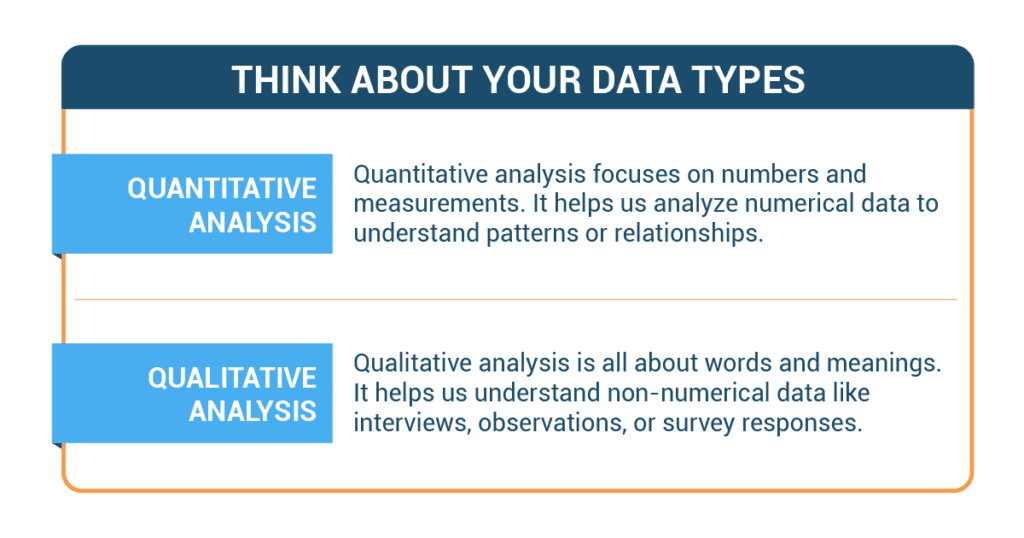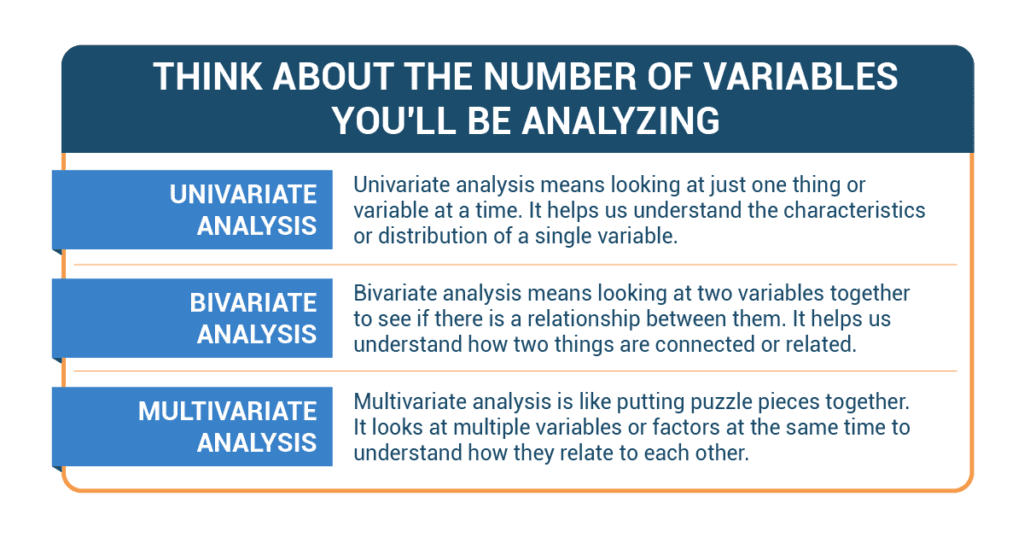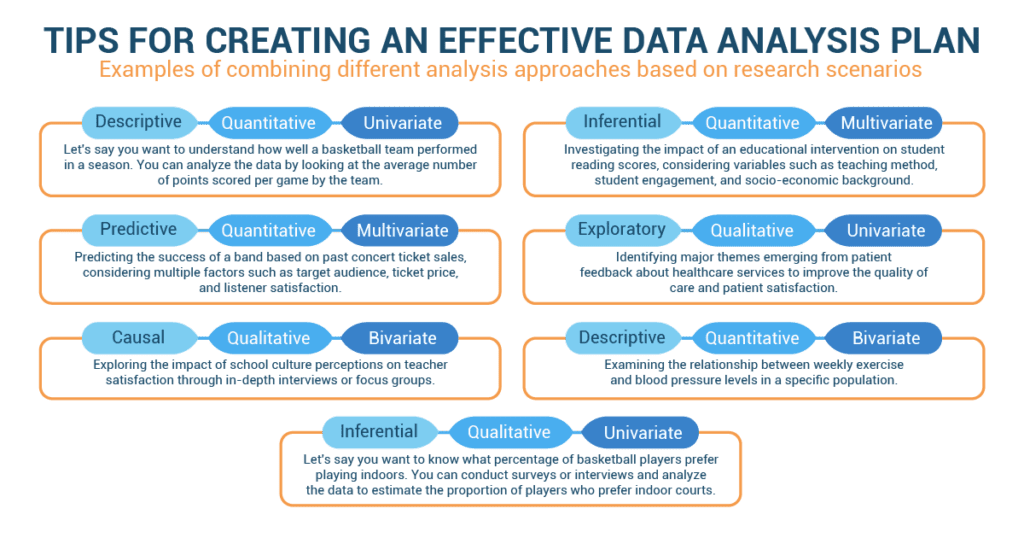Data analysis is all around us, shaping our decisions and the world we live in. Think about the choices you make daily, like picking a movie 🎥🍿 or a restaurant.🍔 You instinctively turn to data analysis, checking reviews, and seeking recommendations.🔍 That’s the essence of data analysis – gathering and analyzing data to make informed choices.
Now, imagine you’re working on a science project. Planning data analysis is crucial to bring clarity to your study. It ensures your research is meaningful, valid, and generates valuable insights. Without proper planning, your project can be confusing and lead to biased or misleading conclusions.
When conducting a research study, it’s crucial to plan not only how you’ll collect data but also how you’ll analyze it. 📈The way you analyze data directly impacts the validity and accuracy of your results. In this article, we will explore the significance of understanding data analysis in the statistical investigative process. By considering your research question, data types, and variables, you can choose the right analytical approach that aligns with your objectives. Let’s delve into the details!🔍📚🔍
Why is it Important to Decide on How You’ll Analyze Data?
Deciding on how you’ll analyze data is important for several reasons:
- Alignment with research question: Choosing an appropriate data analysis method that aligns with your research question is crucial for several reasons. First and foremost, it ensures that the analysis is relevant to the specific objectives and goals of your study. The analysis should directly address the research question and provide insights or answers that contribute to the overall research objective.
- For example, if your research question aims to understand the relationship between two variables, such as the impact of exercise on academic performance, you would need to choose an analysis method that can assess the correlation or regression between these variables. Selecting a method that is not directly related to the research question, such as descriptive analysis that merely summarizes the data, would not provide the necessary information to answer the research question accurately.
- Fit with data: Analyzing data in a manner that is suitable for the collected data ensures compatibility and optimal utilization. Different types of data require specific analysis techniques to extract meaningful insights.
- Quantitative data, which consists of numerical measurements, often lends itself to statistical analysis methods such as t-tests, Analysis of Variance (ANOVA), or regression. These methods allow for the examination of relationships, comparisons between groups, and prediction of outcomes.
- On the other hand, qualitative data, such as interview transcripts or open-ended survey responses, requires qualitative analysis techniques like thematic analysis or content analysis. These methods involve identifying patterns, themes, or categories within the data to gain a deeper understanding of the underlying meanings or perspectives. By selecting an analysis method that fits the data type, you can leverage the strengths of the data and derive meaningful interpretations. Trying to analyze quantitative data using qualitative techniques or vice versa may lead to inaccurate or incomplete results.
- Validity and accuracy: Proper data analysis techniques enhance the validity and accuracy of your results.
- Validity refers to the extent to which the analysis method measures what it intends to measure. By choosing a method that aligns with the research question and the nature of the data, you increase the validity of your findings.
- Accuracy, on the other hand, refers to the degree of correctness or reliability of your results. Selecting appropriate analysis methods ensures that the conclusions drawn from the data are reliable and free from biases or errors. For instance, using inferential statistical tests to assess the significance of relationships or differences in data can provide a level of confidence in the findings.
Choosing the Right Way to Analyze Data
Choosing the right way to analyze data is a critical step in the research process. It involves considering various factors to ensure that the analysis method aligns with the research question, data type, and objectives of the study. Here are some key considerations when selecting an appropriate analysis approach:
Think About Your Research Question
Consider the nature of your research question and select an analysis approach accordingly. Different analysis techniques offer various insights based on your objectives.
- Descriptive analysis: Descriptive analysis is like painting a picture with numbers. It helps us summarize and describe data using numbers and charts. For example, if we want to know the average height of students in a class, we would use descriptive analysis to find that out. A limitation of descriptive analysis is that it only provides information about the dataset at hand and doesn’t allow for conclusions beyond the data.
- Exploratory analysis: Exploratory analysis is like going on an adventure with data. It helps us discover new insights, patterns, or trends that we didn’t know before. It allows us to explore data without having a specific hypothesis or question in mind. A limitation of the exploratory analysis is that it is focused on providing insights about the dataset at hand and doesn’t formally test patterns or confirm causal relationships it finds in the data.
- Inferential analysis: Inferential analysis helps us draw conclusions or make predictions about a larger group or population based on a smaller sample. It uses statistical methods to make educated guesses or inferences about what the whole population might be like based on the data we have.
- Predictive analysis: Predictive analysis is like making educated guesses about the future. It uses data and patterns from the past to make predictions or forecasts about what might happen next. For example, if we want to predict if it will rain tomorrow based on weather data from previous days, we would use predictive analysis.
- Causal analysis: Causal analysis helps us understand cause and effect relationships. It explores how one thing or variable influences or causes changes in another. For example, if we want to find out if eating a healthy breakfast leads to better concentration in school, we would use causal analysis.
Think About Your Data Types
Quantitative and qualitative data require different analysis methods.
- Quantitative analysis: Quantitative analysis focuses on numbers and measurements. It helps us analyze numerical data to understand patterns or relationships. For example, if we want to see if there is a connection between the number of hours students study and their grades, we would use quantitative analysis. Quantitative analysis may overlook the context or subjective differences that qualitative data can provide.
- Qualitative analysis: Qualitative analysis is all about words and meanings. It helps us understand non-numerical data like interviews, observations, or survey responses. It focuses on finding themes, patterns, or insights from the words people use. For example, if we want to understand why students enjoy playing music, we would use qualitative analysis to analyze their written responses. Qualitative analysis often comes at the cost of lost precision since it is asking about words or descriptions that are difficult to measure precisely.
Think About the Number of Variables You’ll Be Analyzing
Consider the number of variables involved in your research.
- Univariate analysis: Univariate analysis means looking at just one thing or variable at a time. It helps us understand the characteristics or distribution of a single variable. For example, if we want to know how many students in a class play a musical instrument, we would use univariate analysis to count and see the results. The univariate analysis doesn’t consider relationships or interactions between variables.
- Bivariate analysis: Bivariate analysis means looking at two variables together to see if there is a relationship between them. It helps us understand how two things are connected or related. For example, if we want to see if there is a relationship between the amount of exercise students get and their grades, we would use bivariate analysis. The bivariate analysis only considers two variables and may overlook the impact of other variables.
- Multivariate analysis: Multivariate analysis is like putting puzzle pieces together. It looks at multiple variables or factors at the same time to understand how they relate to each other. For example, if we want to know how both age and gender affect students’ test scores, we would use multivariate analysis. Multivariate analysis requires larger sample sizes and can be complex to interpret.
Once you’ve considered your objectives, data types, and variables, you can decide on the best analytical approach for your study.
Combining Different Analysis Approaches Based on Research Scenarios
- Descriptive, quantitative, univariate: A type of research where we collect information about a single variable and describe it using numbers.
- Let’s say you want to understand how well a basketball team performed in a season. You can analyze the data by looking at the average number of points scored per game by the team.
- Predictive, quantitative, multivariate: A type of research where we use numbers and measurements to analyze multiple variables and predict outcomes.
- Predicting the success of a band based on past concert ticket sales, considering multiple factors such as target audience, ticket price, and listener satisfaction.
- Causal, qualitative, bivariate: A type of research where we explore the cause-and-effect relationship between two variables using qualitative data.
- Exploring the impact of school culture perceptions on teacher satisfaction through in-depth interviews or focus groups.
- Inferential, quantitative, multivariate: A type of research where we make inferences or draw conclusions about a population based on quantitative data collected from multiple variables.
- Investigating the impact of an educational intervention on student reading scores, considering variables such as teaching method, student engagement, and socio-economic background.
- Exploratory, qualitative, univariate: A type of research where we explore a research topic in-depth using qualitative data focused on a single variable.
- Identifying major themes emerging from patient feedback about healthcare services to improve the quality of care and patient satisfaction.
- Descriptive, quantitative, bivariate: A type of research that aims to describe and analyze the relationship between two variables using quantitative data.
- Examining the relationship between weekly exercise and blood pressure levels in a specific population.
- Inferential, qualitative, univariate: A type of research that aims to make inferences or draw conclusions about a specific characteristic or phenomenon using qualitative data from a single variable.
- Let’s say you want to know what percentage of basketball players prefer playing indoors. You can conduct surveys or interviews and analyze the data to estimate the proportion of players who prefer indoor courts.
Analyzing a Study about Music
 Meet Alex, a high school student who has a deep passion for music. 🎵🔥Alex decides to conduct a research study on the effects of music on concentration and academic performance among his fellow classmates. With a clear goal in mind, he begins planning the data analysis for his study.📊
Meet Alex, a high school student who has a deep passion for music. 🎵🔥Alex decides to conduct a research study on the effects of music on concentration and academic performance among his fellow classmates. With a clear goal in mind, he begins planning the data analysis for his study.📊First, Alex identifies his research question: “Does listening to music while studying impact concentration and academic performance?” This question drives his study and guides his data analysis plan.
Next, Alex considers the type of data he needs to collect. He decides to gather quantitative data through a survey. The survey will include questions about students’ music listening habits, study environment, perceived concentration levels, and academic performance indicators like test scores or Grade Point Average (GPA).
To ensure his data analysis is comprehensive, Alex also plans to include demographic information such as gender, grade level, and musical background. These variables may provide insights into potential differences among students and help interpret the data more accurately.
Alex thinks carefully about the survey design and constructs questions that are clear and unbiased. He wants to ensure that the survey captures the necessary information accurately.
After designing the survey, Alex consults with his teacher to get feedback on his approach. The teacher suggests adding open-ended questions to gather qualitative data about students’ subjective experiences with music and studying. This additional qualitative information will enrich Alex’s analysis and provide a deeper understanding of the topic.
With his data collection plan in place, Alex moves on to recruit participants for his study. He distributes the survey to his classmates, explaining the purpose of the research and assuring them of confidentiality and anonymity. He encourages honest and thoughtful responses to ensure the data collected is reliable.



